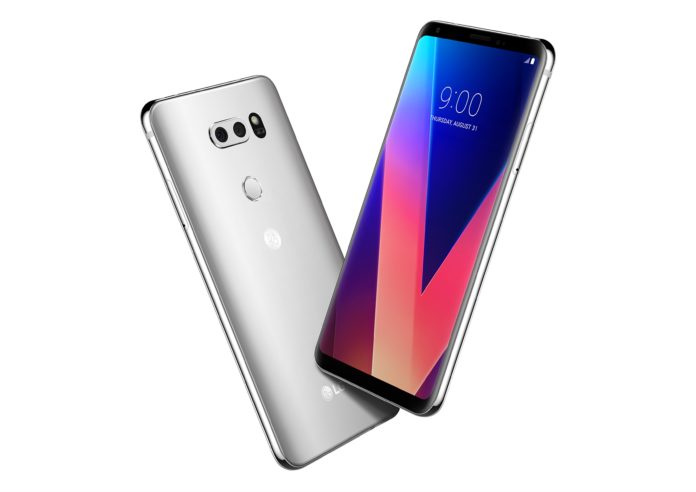After a series of many leaks and revelations, South Korean electronics giant LG on Thursday launched its latest flagship smartphone, dubbed as the “LG V30” at the IFA 2017 event in Berlin. The LG V30 is the successor of the company’s previous audio-centric LG V20, which was launched last year. The main highlights of the smartphone are its revamped design, latest and fastest Snapdragon 835 processor, a gigantic 6-inch QHD+ P-OLED FullVision display, dual rear camera setup with an f/1.6 aperture (first in the smartphone camera industry), Bang & Olufsen powered audio, IP68 certified device, MIL-STD 810G Transit Drop Test certified, and High-grade biometric authentication process.
The LG V30 comes in four exciting body colour options including Aurora Black, Cloud Silver, Moroccan Blue and Lavender Violet and the shipment services will begin starting September 21 in South Korea first, followed by “key target markets” in North America, Asia, Europe, Africa and the Middle East. There is also a high-end variant with 128GB storage, called LG V30+, which will be available in limited markets only. Sadly, the pricing details of the LG V30 has not been revealed by the company yet.
In terms of design, the LG V30 sports a sleek metal unibody design with very thin bezels. There is no physical Home button and navigation buttons on the front panel. The volume rockers are placed on the left-hand edge, while the SIM slot is situated on the right-hand edge of the smartphone. A 3.5mm audio socket is placed at the very top edge of the device, while the speaker grille is seen at the bottom edge of the handset along with a USB Type-C charging port sitting in the middle. Unfortunately, the newly launched LG V30 doesn’t sport a secondary display as the LG V series is known for its secondary display, which we have seen on the company’s V20 and V10. The secondary display offers a quick way to show notifications, email alerts including upcoming events, weather forecasts or customised notifications. But It seems like that the LG V30 ditches the company’s signature secondary display in favour of a bezel-less FullVision display with 18: 9 aspect ratio, similar to the LG G6.

LG V30 Specifications and Features:
In terms of specifications, the LG V30 comes equipped with a gorgeous 6-inch QHD+ P-OLED FullVision display with a screen resolution of 1440 x 2880 pixels and offers a pixel density of 538ppi. The 6-inch OLED display has 18:9 aspect ratio and supports HDR 10 (High Dynamic Range) content. Further, the display is protected by a scratch resistance Corning Gorilla Glass 5. The smartphone also has a second Always-On Display (AOD) with a floating bar situated right above the main display. The Always-On Display can be used to easy access shortcuts and the floating bar can be customised with up to five frequently used applications. Talking about its power and performance, the smartphone is powered by a blazing-fast Qualcomm Snapdragon 835 octa-core processor clubbed with Adreno 540 GPU to handle the graphics. In terms of memory, the LG V30 is backed up by a 4GB LPDDR4x RAM and 64GB internal storage/ (128GB for the V30+), which can be further expanded up to 2TB via a microSD card.
Talking about its software fronts, the LG V30 runs company’s proprietary LG UX 6.0+ custom UI skin, based on Google’s Android 7.1.2 Nougat operating system. LG has confirmed that the LG V30 will get the recently launched Android 8.0 Oreo update pretty soon. The LG V30 is also a Google Daydream ready device that means the device supports VR functionality. For high-grade biometric security, the company brings several new features including Face Recognition, Fingerprint recognition button, and a new Voice Recognition feature supported by Qualcomm Aqstic voice UI technology with always-on, always-listening capabilities, which uses a combination of user’s voice and user-defined keywords to unlock the device.

Talking about its multimedia department, the LG V30 features a 32-bit Advanced Hi-Fi Quad DAC powered by ESS Technology’s SABRE ES9218P and sound tuned by Bang & Olufsen for immersive audio. The Hi-Fi Quad DAC comes with two new features including digital filters and sound presets. The LG V30 also supports Master Quality Authenticated (MQA) technology for high-resolution audio streaming. The LG V30 has passed the US Military Standard (MIL-STD) 810G Transit Drop Test against a subset of 14 specific environmental conditions, including extreme temperature, dust, shock/vibration, etc. The smartphone is also IP68 certified for water and dust resistance. It can survive in up to 5 feet of water for up to 30 minutes or less.
Further, the company has added an advanced signal processing technology in its latest flagship device, now users can be able to instruct the Google AI Assistant more friendly and frequently. Google AI Assistant has unique capabilities such as one can say “Ok Google, take a wide-angle selfie” it responses quickly even while playing loud music.
In terms of photography, the LG V30 houses a horizontally arranged dual rear camera setup that comes combined with one 16-megapixel primary sensor with an f/1.6 aperture and a 71-degree wide-angle lens, and one 13-megapixel secondary sensor with an f/1.9 aperture and a 120-degree wide-angle lens. The main camera features also include Laser auto focus, Phase Detection Autofocus (PDAF), Optical image stabilization (OIS), Electronic image stabilization (EIS) and dual-tone LED flash module. The dual rear camera setup uses Crystal Clear Lens instead of plastic for correct colour reproduction and capturing sharp and clear photographs. On the front, the device features a 5-megapixel front-facing camera with smart autofocus, 90-degree wide-angle lens and an f/2.2 aperture. The rear camera also is capable of recording 4K UHD videos at 30 fps, 1080p Full-HD videos at 30 fps. The camera features also include Touch focus, Panorama, Face detection and much more.

On the connectivity front, the LG V30 offers various connectivity options including 4G VoLTE, Wi-Fi 802.11 a/b/g/n/ac (2.4 GHz & 5.0 GHz), Bluetooth v5.0, GPS/A-GPS/GLONASS, NFC, a 3.5mm headphone jack and a USB 3.1 Type-C port for super-fast charging and other connectivity. Sensors on the smartphone include a Fingerprint (rear-mounted) sensor, E-Compass, Accelerometer, Gyroscope, Ambient Light Sensor and Proximity sensor. On the battery front, the LG V30 comes packed with a high-density 3,300mAh battery with fast charging support both on wired as well as wireless charging. The device also supports Qualcomm Quick Charge 3.0 fast charging technology, which the company claims it can charge the smartphone from 0 to 50 percent in just 30 minutes. Dimensionally, the handset measures 151.7 x 75.4 x 7.3 mm and weighs 158 grams.

























